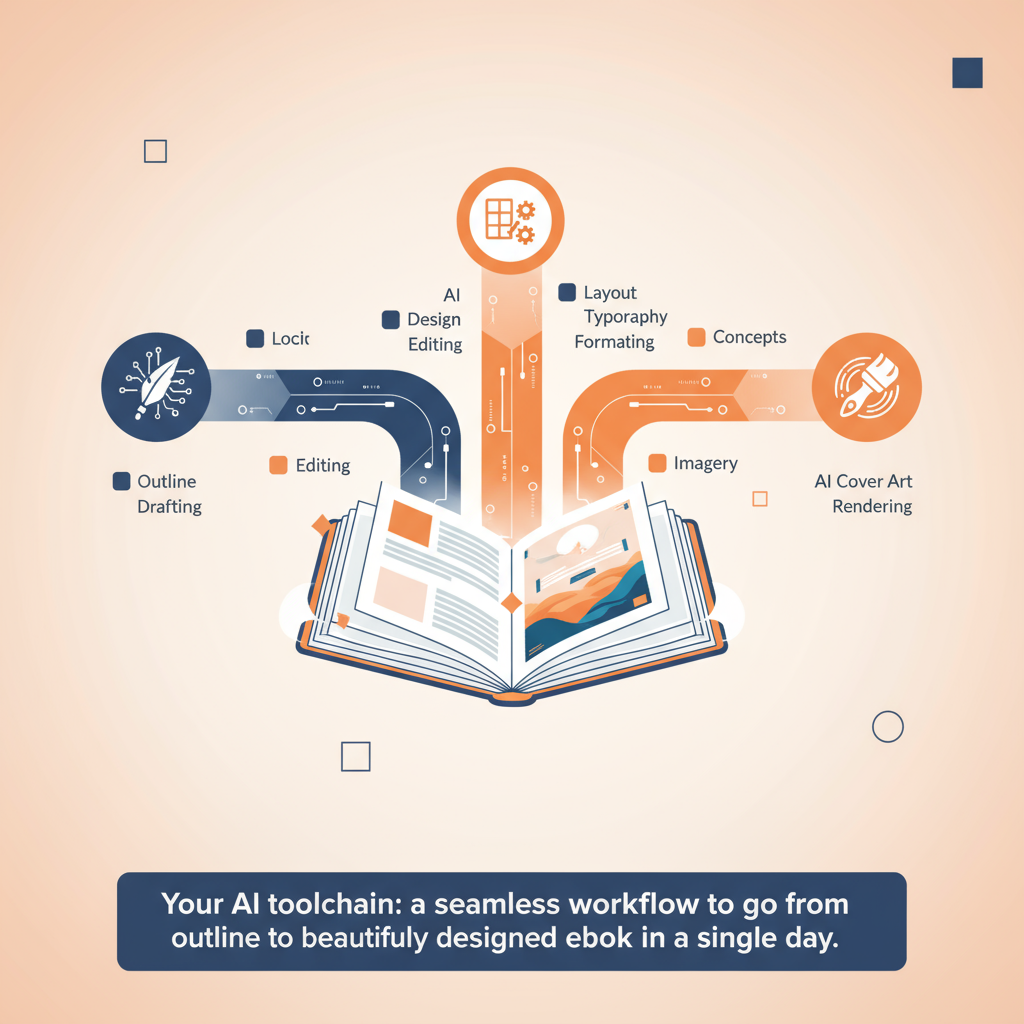Tired of the feast-or-famine cycle of client work? You know the drill: you’re either swamped with projects or hunting for the next one. What if you could build an asset that works for you, even while you sleep? This guide gives you the exact, no-fluff framework to go from a blank page to a launched digital product in one weekend, all powered by a smart stack of AI tools.
Key Takeaways: Build Your Digital Product Engine
- Go from Idea to Income, Fast: Discover a repeatable framework to launch a digital product in just 48 hours, crushing the analysis paralysis that holds most freelancers back.
- Stop Guessing, Start Validating: Learn how to use AI to not only generate ideas but also stress-test them against real market demand before you write a single word.
- Master the AI Toolchain: We’ll show you how to connect specific AI tools—like GPT-4, Midjourney, and Descript—into an efficient workflow for creating high-quality ebooks, templates, and courses.
- Launch with Confidence: Build a professional sales page in under an hour and automate your product delivery, so you can start making sales immediately.

Step 1: Validate Your Product Idea Before You Build (Friday Night)
A great product nobody wants is just a hobby. Before you dive into creation, you need to make sure you're building something people will actually pay for. In the past, this meant weeks of research. Now, you can get a strong signal in about an hour.
Your goal isn't just to find an idea, but to find a problem. What's a repetitive, annoying task your clients always struggle with? What's the one piece of advice you give over and over? That’s your starting point. Don't know? Ask an AI.
The 60-Minute AI Validation Framework
- Problem Brainstorming (20 mins): Use GPT-4 with a prompt like: "I am a freelance [Your Skill, e.g., 'copywriter for SaaS startups']. What are 10 common, expensive, or time-consuming problems my clients face that could be solved with a template, guide, or micro-course?"
- Audience & Keyword Triage (20 mins): Pick your top 3 ideas. Now, ask the AI: "For each of these problems, who is the specific person looking for a solution? What phrases would they search on Google to find it?" This gives you the keywords you'll need for your sales page later.
- Competitive Scan (20 mins): Search those phrases. Are others selling solutions? Good! It means there's a market. Your goal isn't to find an empty space; it's to find a space you can enter with a unique, AI-powered angle. For a deeper dive on this, check out our guide to validate your business idea with AI.
Before: A vague idea for an "ebook for startups."
After: A validated concept for a "ChatGPT Prompt Library for SaaS Onboarding Emails," targeting B2B content marketers.
Step 2: Choose Your Blueprint & Build Your Product (Saturday)
Forget generic lists of "product ideas." We're focused on three proven, AI-native blueprints you can realistically execute in a day. Pick the one that best fits your skills and your validated idea.
Blueprint 1: The Niche Ebook or Guide
This is the classic digital product, supercharged. You're not writing a 300-page novel; you're creating a dense, high-value PDF that solves a single, painful problem.
- The Toolchain: Notion AI (for outlining) → GPT-4 (for drafting chapters) → Gamma.app (for beautiful formatting) → Midjourney (for cover art).
- The Workflow:
- Ask Notion AI to create a detailed outline for your topic. Tweak it for flow.
- Feed each outline point into GPT-4 as a prompt. Example: "Write a 500-word chapter on 'Crafting the Perfect Welcome Email' for a new SaaS user. Use a friendly, expert tone and include 3 actionable tips."
- Paste the raw text into Gamma.app and let it handle the design and layout.
- Generate a stunning, professional cover image with a simple prompt in Midjourney, like: "minimalist ebook cover design, abstract geometric shapes, blue and orange, for a book about marketing funnels --ar 2:3".

Blueprint 2: The High-Value Template Pack
Templates sell because they offer a shortcut. Don't just sell a single template; sell a system. This moves you from a commodity to a solution provider.
- The Toolchain: Notion AI (for structure) or GPT-4 (for content) → Your native tool (Notion, Google Sheets, Figma).
- The Workflow (Example: Client Acquisition Notion Dashboard):
- Use Notion AI to brainstorm every component of a freelance client acquisition system (e.g., CRM, outreach tracker, proposal templates, contract templates).
- Build out this structure in a clean Notion page.
- Use GPT-4 to write the content for the templates, like a pre-written cold email sequence or a proposal draft. This is a massive value-add. This shifts you from just selling a productized service to selling a replicable system.
Blueprint 3: The AI-Powered Micro-Course
Video feels daunting, but AI makes it shockingly simple. A micro-course is a series of 5-7 short videos (2-5 minutes each) that walk a user through a specific process. No camera required.
- The Toolchain: GPT-4 (for scripts) → Synthesia (for AI avatar presenter) → Descript (for editing & screen recording).
- The Workflow:
- Generate a concise script for each video module using GPT-4.
- Paste the script into Synthesia and choose an AI avatar to present it. It creates the video for you.
- Need to show a process on screen? Record your screen and voice with Descript. It transcribes the audio, and you can edit the video just by editing the text. It’s magic. Cut out filler words with a single click.
Before: Spending weeks filming and editing a course.
After: Generating a professional, 7-module micro-course in an afternoon without ever turning on a camera.
Ready to Sell Your New Product?
Your digital product deserves a high-converting home. Don't waste a week building a complex website. Use Livesume's Landing Page builder to launch a professional, secure sales page in under an hour. Start selling this weekend.
Step 3: Launch & Automate Your Sales Machine (Sunday)
With your product finished, the final step is to build its home on the internet. This doesn't need to be complicated. You need a single, focused page that does one thing: sell your product.

Your Weekend Launch Checklist
- Craft Your Sales Page Copy (1 hour): Use GPT-4 with what you learned during validation. Prompt it: "Write sales page copy for my [Product Name]. My target audience is [Audience] and the main problem it solves is [Problem]. Focus on the transformation, not just the features."
- Build Your Sales Page (1 hour): This is where speed is critical. A tool like the Livesume website builder is perfect for this. Pick a template, drop in your copy, add your cover image, and connect a payment processor like Stripe or Gumroad. Check out some examples of high-converting pages for inspiration.
- Automate Delivery (30 mins): Use a tool like Zapier or your payment processor's built-in features to automatically send the customer a link to the product (e.g., a PDF in Dropbox, a link to a Notion page) as soon as they pay. Set it up once, and it works forever.
- Initial Promotion (The Rest of the Day): You don't need a huge budget. Write a post for your social media channels (LinkedIn, Twitter, etc.) announcing your new product. Email your professional network. The goal is to get your first few sales and gather feedback. We cover more on this in our guide to the personal branding tech stack.
Frequently Asked Questions
What are the most profitable digital products for freelancers?
The most profitable products solve a specific, expensive problem. Instead of a generic "social media template," create a "LinkedIn Content Strategy & Template Pack for Financial Advisors." Niche-specific B2B products like templates, workshops, and high-value guides typically command higher prices than general consumer products.
How can I use AI to create an ebook from scratch?
Use a chained workflow: 1. Brainstorm and outline with Notion AI. 2. Draft each chapter with GPT-4 by feeding it the outline points one by one. 3. Use an AI-powered design tool like Gamma.app to format the raw text into a visually appealing document. 4. Generate a unique cover with an image AI like Midjourney.
What are the best AI tools for creating an online course?
For a no-camera-needed micro-course, the best stack is GPT-4 (for scripts), Synthesia (for an AI avatar presenter), and Descript (for screen recordings and editing). Descript is especially powerful because it lets you edit video by editing text, which is incredibly fast.
Is it legal to sell digital products made with AI?
Yes, generally. Most AI tool platforms grant you commercial rights to the content you create. However, you are responsible for the final product. Always review the terms of service for the specific tools you use, and make sure you heavily edit and fact-check any AI-generated text to make it your own original, copyrighted work.
How do I know if my digital product idea will sell?
The fastest way to validate is with a "pre-sale." Create your sales page and a simple mockup of your product. Announce you're launching it next week at a special early-bird price. If you get a handful of sales before you've even finished it, you know you have a winner. If not, you've only invested a day, not a month.
Should I sell digital products on Etsy or my own website?
For professional freelancers, selling on your own site (like a Livesume professional page) is almost always better. You build your own brand, control the customer experience, keep a larger percentage of the revenue, and can build your own email list. Etsy is better for high-volume, low-price creative assets and puts you in direct competition with thousands of others.
How can I deliver my digital product to customers automatically?
Most modern payment gateways like Gumroad, Lemon Squeezy, or Stripe have built-in features for digital product delivery. Alternatively, you can use a tool like Zapier to create an automation: when a purchase is completed in your payment tool, Zapier automatically sends an email to the customer with the download link.
Turn Your Weekend Project Into a Revenue Stream
You no longer need a team or months of development to build a valuable digital asset. The barrier between idea and income has never been lower. Following this framework doesn't just give you a product; it gives you a new skill set.
Here's how to start:
- Block off time this weekend. Seriously, put it on your calendar.
- Run the 60-Minute Validation Framework. Pick one problem to solve by Friday night.
- Build your V1 product on Saturday. Don't aim for perfection; aim for completion.
- Launch your sales page on Sunday. Your goal is to get your first sale.
By Monday, you'll have transformed from a service provider into a product creator with a scalable asset that can fuel your freelance business for years to come.